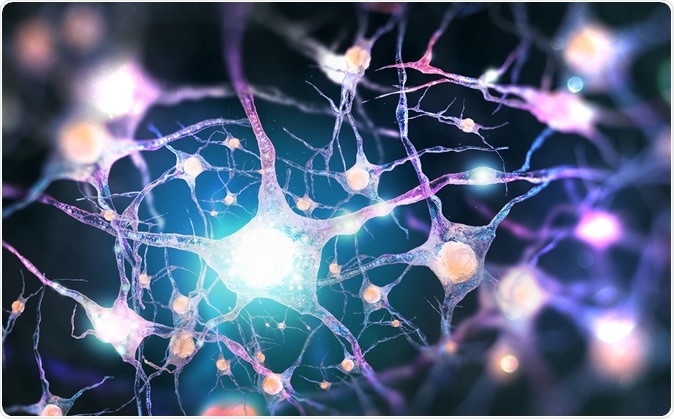Our bodies couldn’t operate without the central nervous system - a complex network that coordinates our actions, reflexes, and sensations. Each neuron in your brain has one long cable that snakes away from the main part of the cell. This cable, several times thinner than a human hair, is called an axon, and it is where electrical impulses from the neuron travel away to be received by other neurons. Neurons cannot properly communicate if axons are damaged or broken. This can happen both with nerve injury, and also in the earliest stages of neurodegenerative diseases such as motor neurone disease (MND), Alzheimer’s Disease and Parkinson’s Disease.
Just like a packaging breakdown can restrict and halt the delivery of cables and connectors to a house under construction, halting the production of a protein in the brain blocks the growth of axons, a new study says.

Neural network Human nervous system. 3D illustration Credit: Andrii Vodolazhskyi / Shutterstock
A team of researchers at the University of Wisconsin-Madison reports that stopping the production of synaptotagmin 17 (syt-17) blocks the growth of axons, which are long thread-like parts of a nerve cell where impulses are conducted.
Axons transport information to dendrites on other nerve cells, to relay messages. This complex network is the backbone of the nervous system, which is vital for survival and body processes.
On the other hand, when cells created more syt-17, it accelerates and hastens the growth of axons, which is important to maintain an intact nervous system network. Many types of neurological conditions could someday benefit from axon growth, which includes some neurodegenerative diseases and spinal cord injury.
Important roles of synaptotagmin 17
The study, which was published in the journal Nature Communications, sheds light on the important roles the protein plays in many brain functions. The protein, syt-17 or synaptotagmin 17, was made by the 17th synaptotagmin gene to be identified.
The synaptotagmin proteins have been widely known for their role in controlling and regulating the union of intracellular vesicles with the plasma membrane. But, in the study, the researchers report that syt-17, an unusual isoform of unknown function, plays no known role in exocytosis, but rather, plays a multitude of roles in intracellular membrane trafficking.
“Lots of work has been done on this family since it was discovered in 1981," Edwin Chapman of the Howard Hughes Medical Institute and the University of Wisconsin-Madison and lead author, said.
The synaptotagmin proteins are calcium sensors that activate the release of chemical messengers, dubbed as neurotransmitters that are used by the nerve cells to communicate when calcium ions are present. Chapman added that calcium ions are important in communication in the nervous system. They are basic signals; hence, synaptotagmin proteins are being investigated.
Tracing syt-17 to the Golgi apparatus
To arrive at their findings, the researchers traced syt-17 to the Golgi apparatus, which is considered the shipping center in the neuron that packages proteins to be delivered from one part of the cell to the axon end, where growth happens.
Chapman emphasized that these proteins are like supplies, without them, you can’t build anything. One of the ways that neurons can build long, and complicated axons is through the proteins speeding up or hastening the production line.
An accidental discovery
It was six years ago that the team started observing axon growth related to syt-17. In fact, the current study stemmed from an accidental discovery in Chapman’s lab when they were studying the various synaptotagmin proteins inside the nerve cells.
They found that the syt-17 made the axons really long, and they decided to continue working on it.
"To grow an axon, you've got to send a lot of stuff down pipelines that supply the growing end of an axon. Think of building a house: You need shipments of studs, floor joists, and roof shingles. A growing axon needs its own parcels, though they are much smaller,” Chapman explained.
The team also discovered that the protein has another function. David Ruhl, the study co-author, began to observe that the protein had a second pool in the neuron and it had split personality. In the long run, he noticed it performs two unrelated things in the same cell.
Further investigation revealed that the first pool of proteins worked in signal shipping, while the other stash was located in the dendrite, the signal sensor of the synapse, which is the junction between two neurons for communication.
Eventually, he unveiled that the second pool reduces synaptic communication by keeping a reserve of receptors in the nerve cell. These receptors connect to neurotransmitters in the synapse.
“Without syt-17 (at the dendrite) most of the receptors wind up on the surface and synapses are turned up to 11,” Ruhl added.
Moreover, the team said that it is important to increase or decrease receptivity to neurotransmitters in brain plasticity. Without this control, the neurons could just work and fire uncontrollably, which can lead to conditions such as seizures.
Thus, the team concludes that syt-17 plays important roles in brain functions. It doesn’t just help in axon growth, but also, it regulates and controls how the synapses respond or reply to certain signals.
Source:
Journal reference:
Synaptotagmin 17 controls neurite outgrowth and synaptic physiology via distinct cellular pathways
David A. Ruhl, Ewa Bomba-Warczak, Emma T. Watson, Mazdak M. Bradberry, Tabitha A. Peterson, Trina Basu, Alyssa Frelka, Chantell S. Evans, Joseph S. Briguglio, Tamara Basta, Michael H. B. Stowell, Jeffrey N. Savas, Avtar Roopra, Robert A. Pearce, Robert C. Piper & Edwin R. Chapman, Nature Communications volume 10, Article number: 3532 (2019), https://www.nature.com/articles/s41467-019-11459-4